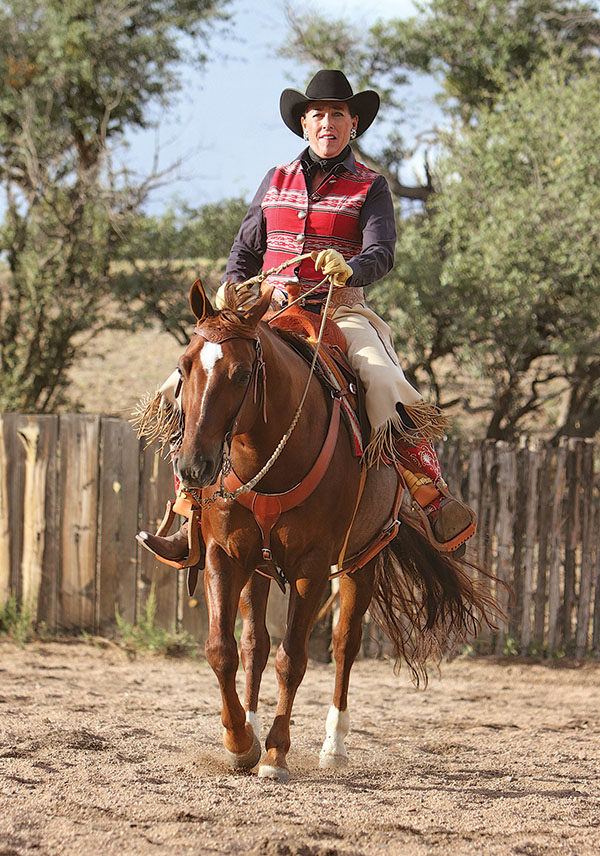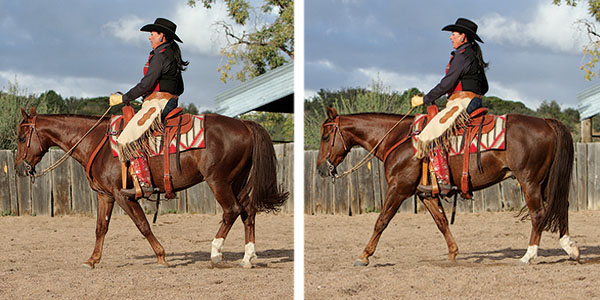Q Ranch riding patterns often ask for an extension at the walk. How can I achieve this extension without breaking into a jog? Is there a way to encourage my horse to extend his walking stride, while maintaining correctness, without breaking gait?

JULIE BARNES, Idaho
A I’m commonly asked questions about gait extension in my clinics and when I judge ranch riding classes. Before I cover tips for achieving the extended walk, I’ll clearly define what gait extension is and what it isn’t. This will help you better understand the techniques for achieving a longer stride on demand.
[WATCH: INTRO TO RANCH RIDING – EXTENDED WALK]
Gait Extension, Explained
The first thing to remember with gait extension is that, done correctly, the horse’s stride reaches farther than during a normal step. Some riders mistakenly believe that a gait extension means traveling at a faster rate. A longer stride will cover more ground in less time. False or incorrect gait extension simply adds more short strides to travel at a faster pace.
As with any gait, cadence is key. A walk has four distinct beats, whether it has an extended stride or a normal step. Keeping that cadence in mind is essential to maintain a true gait.
How to Get the Reach
In my training program, any gait extension is all about the cues. It doesn’t matter what the cue is, as long as it works for you. When I want my horse to move from the walk to the jog, I use steady pressure from both legs. To extend within a gait, I alternate bumping one side and then the other with my legs in sync with my horse’s stride. I keep the cues black and white—that is, completely distinct from each other—to clearly communicate what I want my horse to do. Without clarity, he’ll get confused and frustrated. If my horse breaks into a jog when I’m asking him to extend, I stop him and back up. He soon realizes it’s easier to take a longer stride than it is to stop and back every few feet. It takes lots of practice for the horse to associate the leg-bumping cue with reaching farther in his stride, but be consistent and he will catch on.

Once your cues are well-established, have a friend grab her horse and saddle up for a walking race. Begin side by side, and race at a walk to a designated finish line. If your or your friend’s horse breaks gait, the jogger must go back to the starting line. You’ll be able to push your horse and see just how far you can stretch his stride without breaking gait. We’ve done these races at horse shows for fun, and everyone enjoys them.
Avoid Exaggeration
A true horseman gets the most done with as little visible cueing as possible. When practicing gait extension at home, you can use your body more actively. This can help your horse catch on to your cues. But when you get to the show, it should look easy and natural, and done as “invisibly” as possible. Over-use of your legs, seat, and upper body at a horse show is distracting to the judge and unpleasing to the eye.

Gaits can also become too exaggerated—or downright incorrect—for the horse. Your horse’s “look” when he extends his gait will depend on what you’ve taught him at home. I do caution that it must be a four-beat gait. You must feel each hoof strike the ground. If you feel a skip or a hitch in his gait, you’re probably doing a “single-foot gait.” It’s a missed beat, with only one foot on the ground. It has a very different rhythm, and isn’t a gait recognized in stock-horse breeds.
Laurel Walker Denton, Skull Valley, Arizona, is a lifelong horsewoman and competitor. She grew up on the Bar U Bar Ranch where she and her husband, Barry, reside. Denton, an AQHA and NRCHA judge, has trained and shown horses to great success in working cow horse, reining, and ranch riding. The Bar U Bar Ranch has earned the AQHA 50-Year Breeder award. Learn more about her program at barubar.com.






